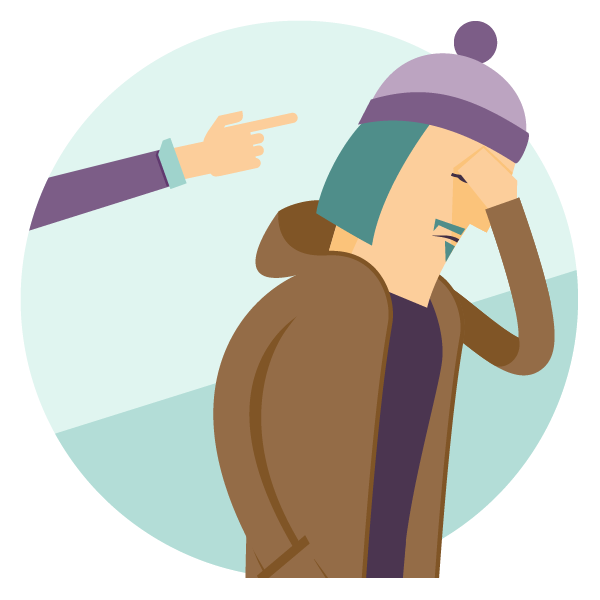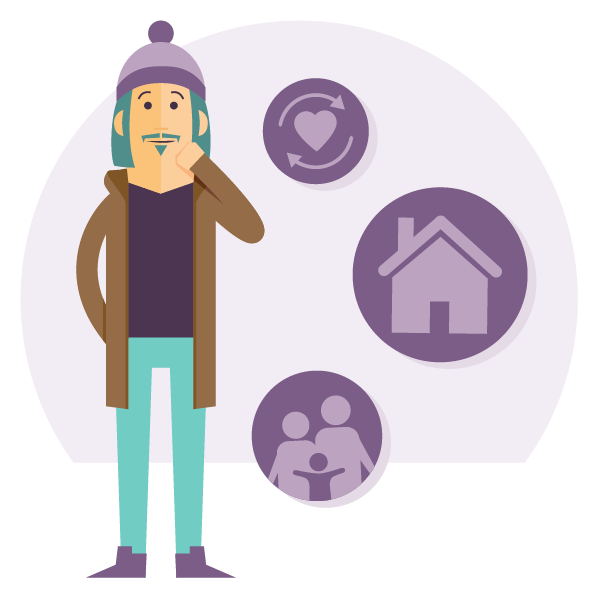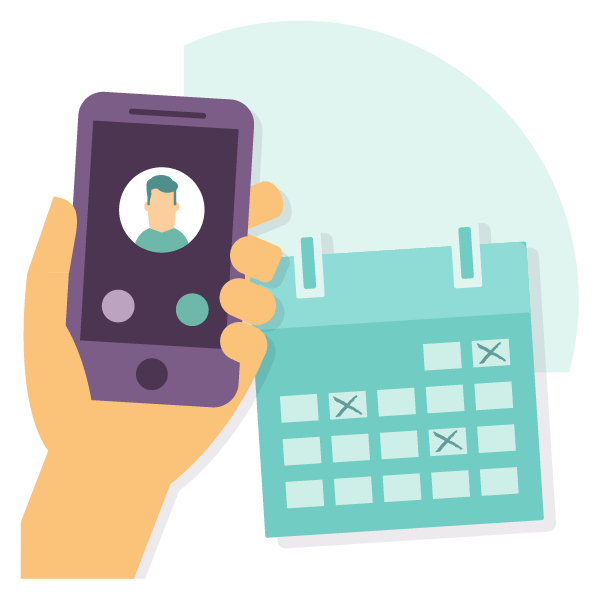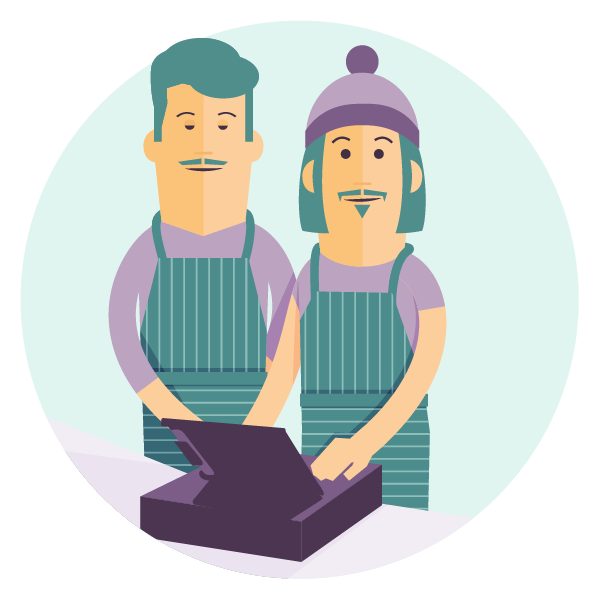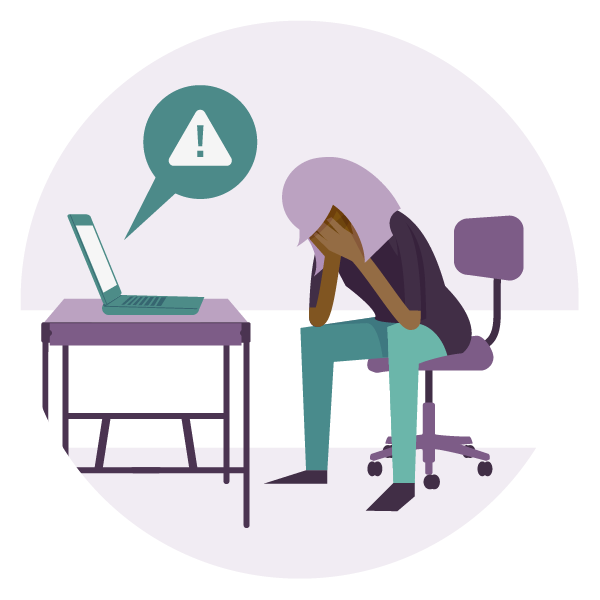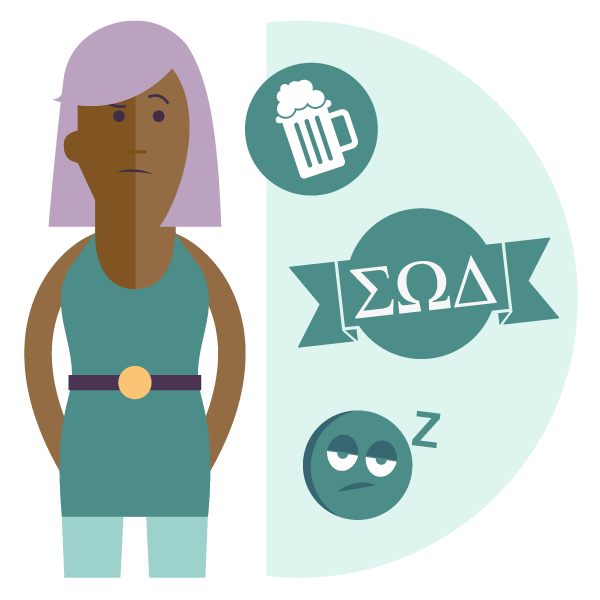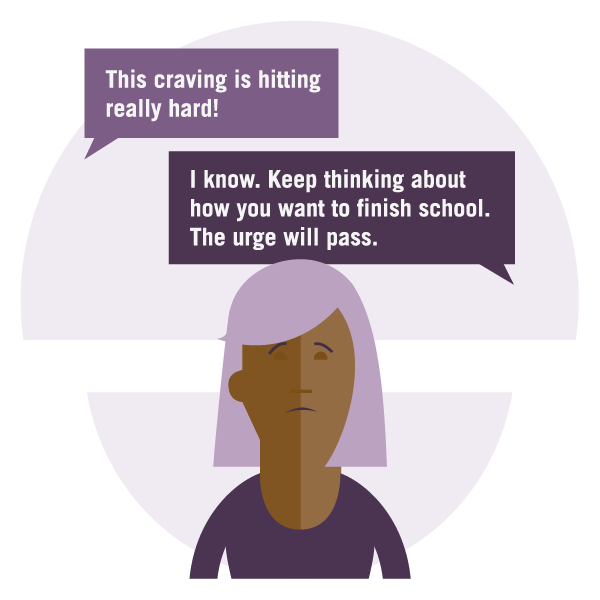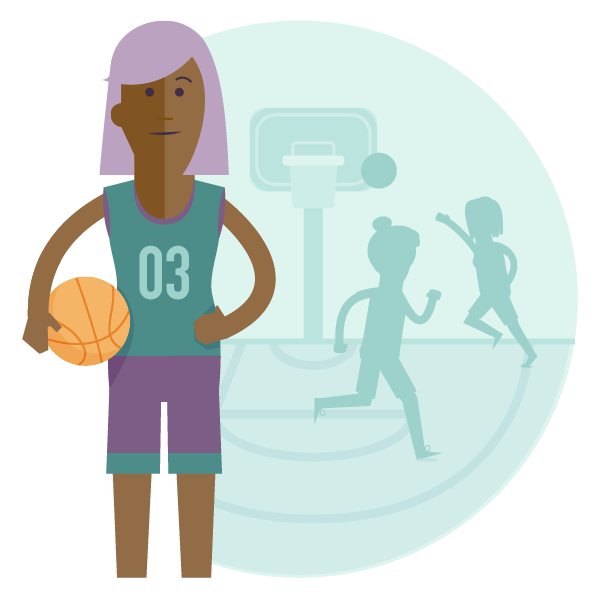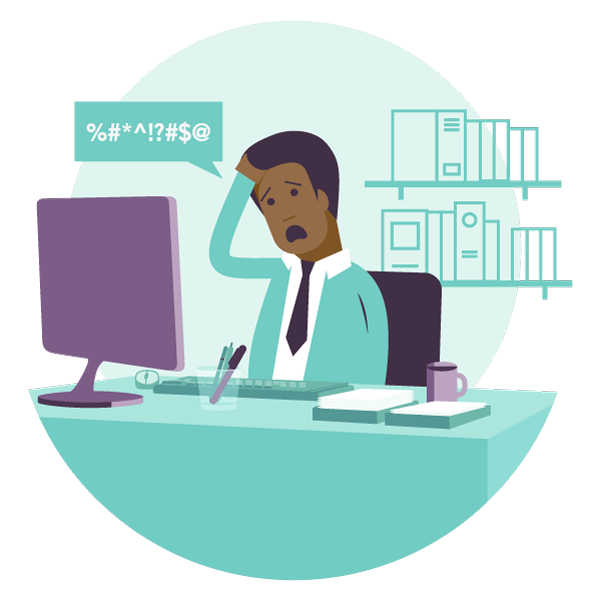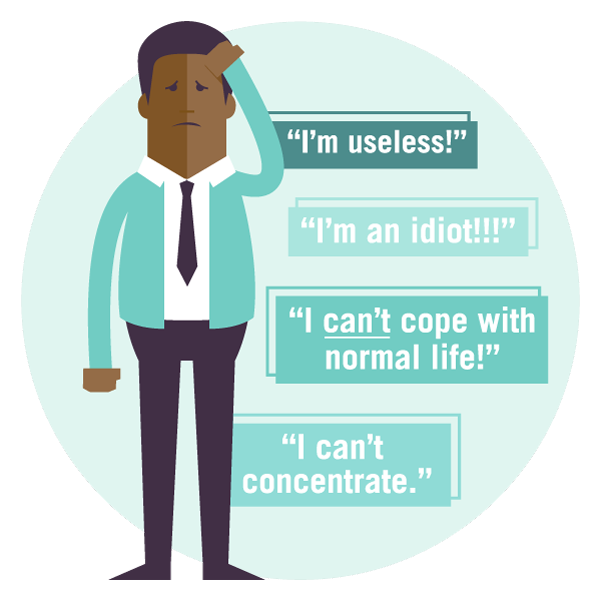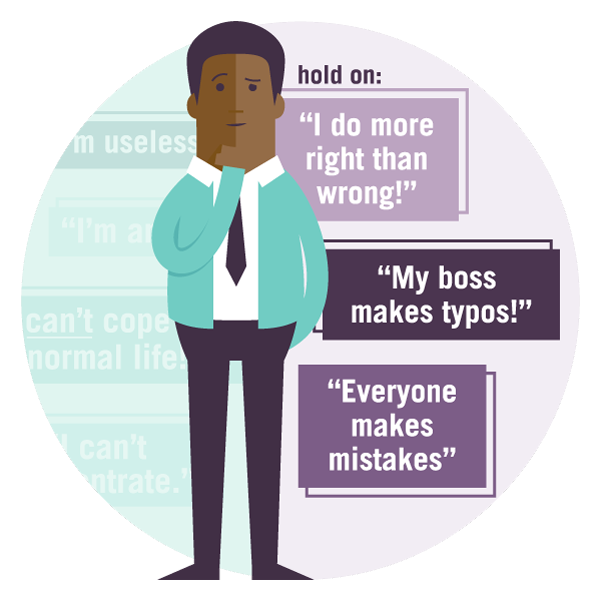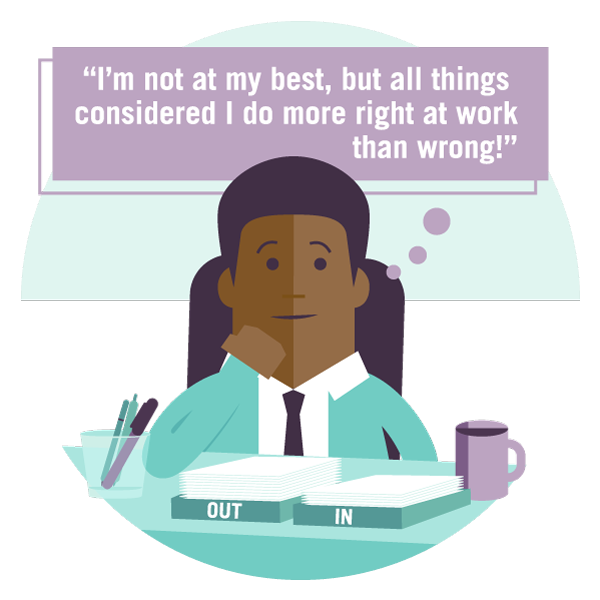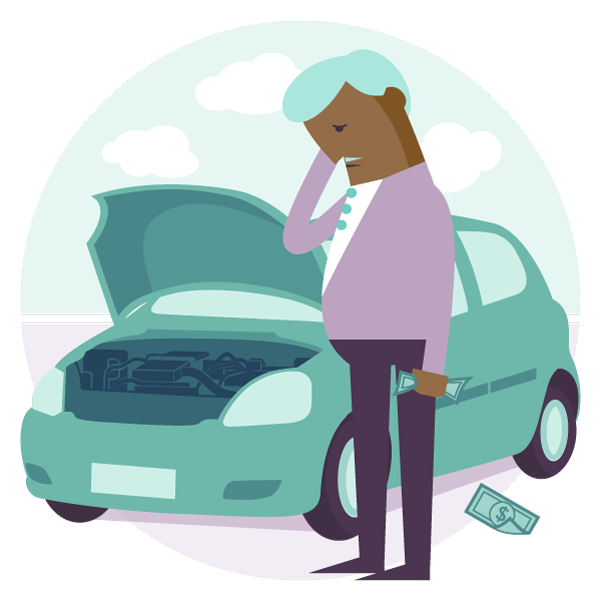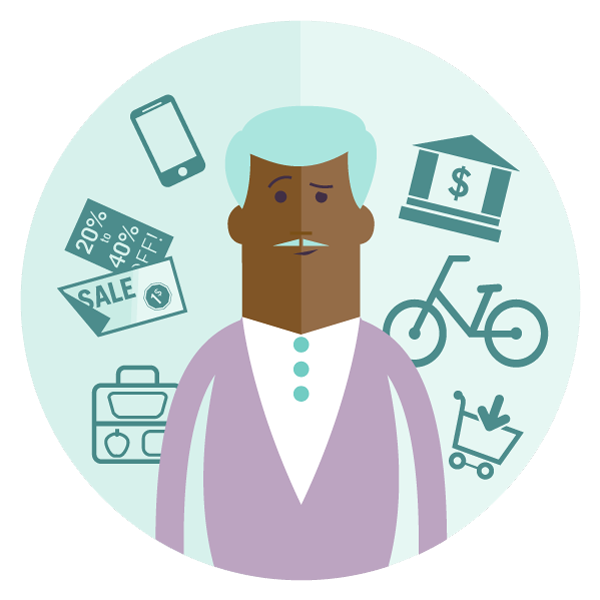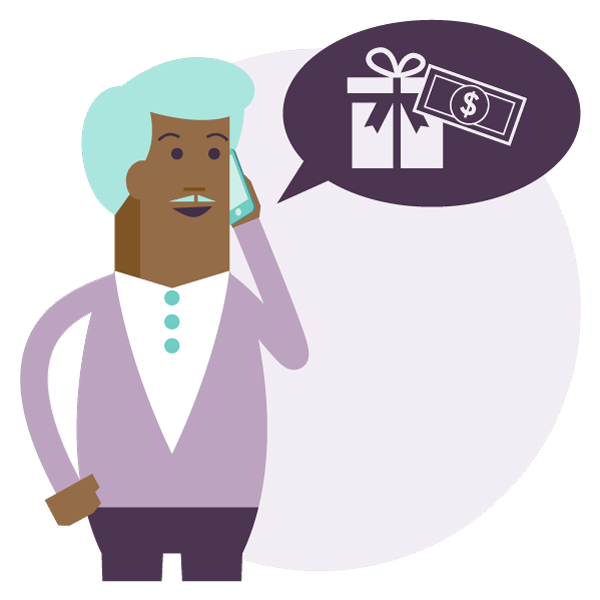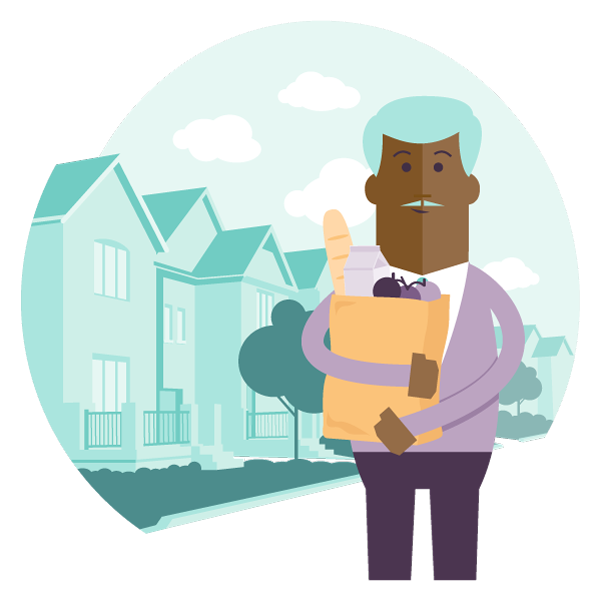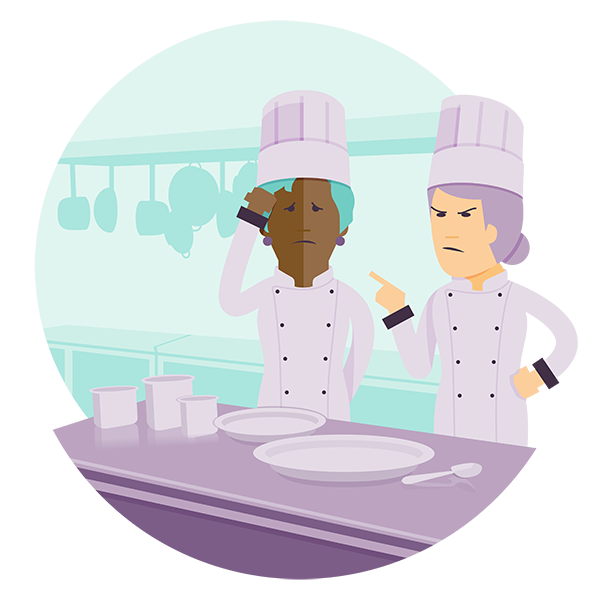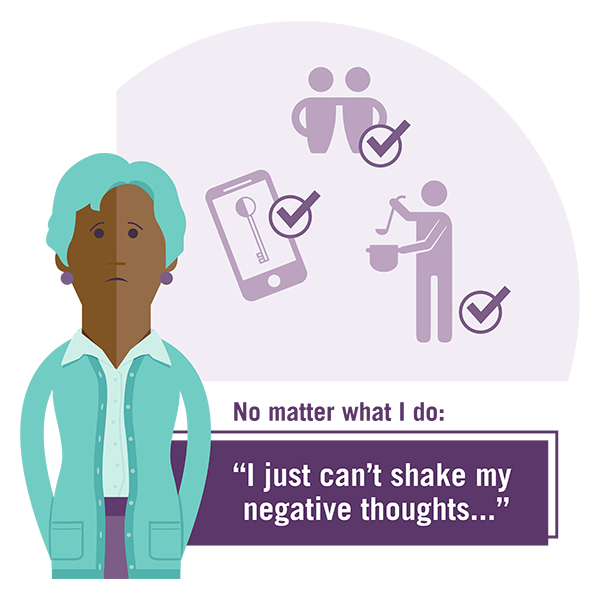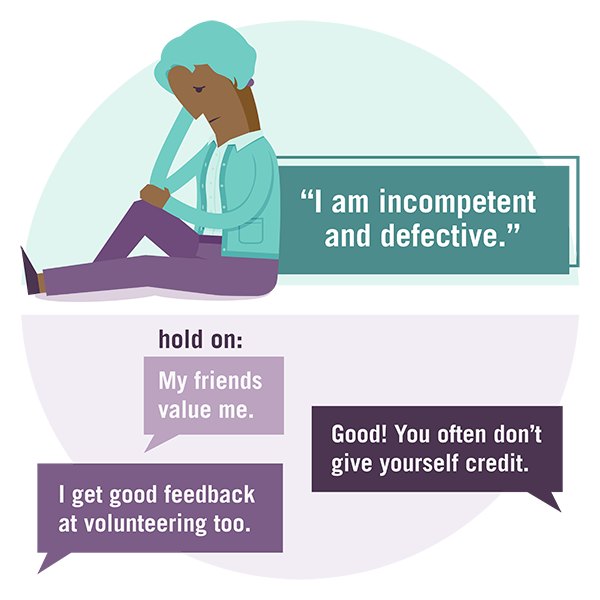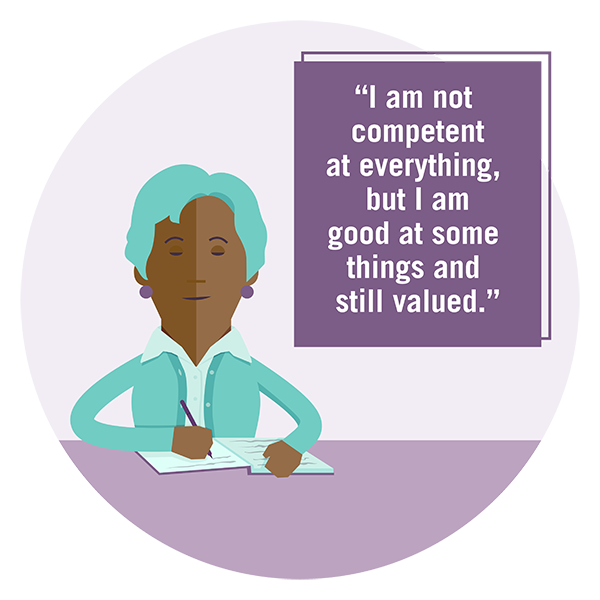Substance Use Problems
Many people use drugs, alcohol, and other substances in their lives. For some people, substance use can lead to problems. It can start to interfere with your life and get in the way of your goals. Here you’ll learn how to spot a problem with substance use and cut down.
You can use any lesson at any time. However, therapy for substance use problems usually uses this order:
Learn the facts about substance use problems -- what they are, how they start, and most importantly, how to treat them.
Making a change in your substance use is hard. Knowing your values will help you find and stick with meaningful goals.
When a strong urge to use substances takes over, it can be hard to say no. Here you'll learn ways to cope.
Certain ways of thinking can lead you back to substance use. In this unit, you’ll learn how to work with these problematic thoughts.
In this unit, you will learn how you can feel better by challenging the thoughts that bring you down.
When you've got a problem, you need to do more than challenge negative thoughts. Here you'll learn how to cope in these situations.
When certain thoughts seem immune to challenging, a core belief might be keeping you stuck. Here you’ll learn how to rework them.
Anxiety creates muscle tension and makes it hard to relax. Learning to relax is a skill that will help you reverse the cycle of anxiety.
Keep practicing. Download reusable worksheets and other tools to keep you going.
What are Substance Use Problems?
6minThere are many substances that people use in their lives. They may help us cope or improve our experience. But for some people, substance use can also bring about problems. In this unit, you’ll learn more about your use. You can decide if there are downsides to it, and whether cutting back or stopping might be helpful.
- The Facts
- Understanding Substance Use
- The Symptoms
- Treatment
! For your privacy, this site does not save what you type. To save it or have a therapist review it, please download your work at the end of your session.
The Facts
It’s Common
Most people have used substances at some point in their lives. Many start their morning with a coffee to feel more alert. Ads for alcohol products are widespread. But there are a few trends. Generally, women tend to use substances less than men. And for most people, their use reduces as they get older, and their priorities change.
Legal and Illegal Drugs
The legal status of substances has always been a hot topic. Many have changed in status, depending on the politics of the time. Take marijuana in Canada. It was illegal, then decriminalized, and now legal. Legal drugs are easy to get, and more people develop problems with their use. About 9% of people experience significant problems with alcohol use in a given year. The rate of tobacco use problems is around 13%. On the other hand, less than 1% of people experience issues with cocaine.
Why People Use Substances
There are many reasons why you may use substances. By changing the signaling in your brain, they can make you feel better. Drugs or alcohol may bring you pleasure or take away your pain. They can change your thoughts, your emotions, your sensations, or your behaviors. You may use drugs to have fun or to cope with tough times.
Substances can also be used socially. They might make it easier for you to open up or talk. Alcohol makes some people feel less shy and more connected to others. You might also get close to people who use the same drug as you. Co-workers who smoke cigarettes might become friends as they spend time together during smoke breaks.
Many cultures use substances in rituals. They may enhance your spiritual experience. Finally, doctors use some substances, like opioids, as a type of medicine.
When Substance Use Becomes a Problem
It can be hard to spot when someone has a problem with substance use. It’s not about how much you take or how often. An amount that is safe for one person may be problematic for another. Instead, ask yourself whether your use is getting in your way. Is it interfering with your life? Does it stop you from achieving your goals or living your values? Do substances play a positive or negative role in your life?
If you aren’t sure whether your use is a problem, there are a few clues. The first is avoiding withdrawal, the sensations you feel as a drug wears off. “Coming down” tends to feel like the opposite of your high. If cocaine makes you energized and joyful, withdrawal might make you tired and depressed. If you find yourself using more cocaine to avoid these sensations, you might have a problem. You may feel trapped in this cycle of use, and need more and more of the drug to get the same high.
How you spend your time in a day can be another sign of trouble with substance use. If most of your energy goes into getting substances, using them, and recovering, there won’t be time for much else. You’ve probably given up other things you once enjoyed. Craving substances can also take up a lot of your time. It can make it hard to focus on other things.
Losing control can be another hint that you may have a problem. Do you find yourself using more of a substance than you meant to? Have you tried to cut down but couldn’t? If you answered yes, substance use is likely interfering with your life.
The last clue that you may have a problem is that you continue to use despite major downsides. Is drug use harming your relationships? Is it causing issues at work, but you keep using anyways? Have you had problems with your mental health that seem to be related to your use? Perhaps your substance use is putting you in dangerous situations. Are you using drugs while driving? These are all signs that your substance use has become an issue.
Symptoms of Substance Use Problems
Substances can change the way you function in many ways:
Different substances have different effects on your thoughts. Your thinking may ramp up or slow down. Your beliefs can also be affected. You might feel super capable, very loved, or like others are out to get you. A lot of substances create significant changes in your memory and attention. With time, your thoughts may become more and more focused on getting and using drugs. Some drugs, like Crystal Meth, can cause long-term harm to the brain.
Most people use drugs because of the emotional changes they bring. They may make you feel euphoric, serene, or excited. But as a substance wears off, you might feel the opposite. You might shift from feeling calm to anxious. Over time, how you feel about yourself may change. As society looks down on drug use, many people start to feel ashamed and guilty. If substance use takes over, and other parts of your life get neglected, it's common to feel anxious or depressed.
Different substances affect your body in different ways. You may get a rush of energy or become completely relaxed. Withdrawal can come in many forms, like complete exhaustion or seizures. While using substances, you might start to forget about taking care of your body. Over time, you may suffer from damage to your teeth, skin, or internal organs. How you take a drug can also affect your body. For example, smoking can cause severe damage to your lungs.
What you do while on a substance will match how it affects your body. You may become very active or fall asleep. Many people tend to only use substances in particular situations. For example, you may have been a heavy drinker in college, but stopped after graduating. If you start doing things you usually wouldn't do to get drugs, you may have a problem with your use. If you feel ashamed, you may try to hide your use from friends or family.
Treatments
If you’ve realized you have a problem with substance use, there is good news. There are ways to cut back or stop altogether. Different kinds of therapy and medications can get you feeling better:
Psychotherapy
There are many types of psychotherapy or talk therapy. Kelty’s Key is based on cognitive behavioral therapy (CBT). This method focuses on how your thoughts and beliefs can help you make a change to your use. It can also teach you how to cope with cravings and deal with life’s tough times.
Medications
You can also use medications to cut back on substance use. Some can ease your withdrawal, and others can treat overdoses. You may also take medicine if you have a mental health issue happening alongside your use. Talk to your doctor to learn more about medications for substance use.
It’s important to know that cutting back on some drugs, like alcohol or benzodiazepines, can be dangerous. The withdrawal symptoms can be fatal. Also, remember that if you’ve cut back or stopped opioid use, your risk of an overdose goes up if you start using again. Get help from a trusted professional and keep yourself safe when you change your use of these drugs.
Well Done. You’re on Your Way.
You’ve taken the first step and learned about substance use problems. Knowledge is important. Understanding the problems that can come with substance use will help you moving forward.
Committed Action
20minCutting down on your substance use can be a significant life change. Sticking to it is tough. It can be hard to stay committed to your goals long term. Looking inside yourself and discovering your values can help. When your goals align with what’s important to you, it can be easier to stick it out.
- Commitment
- Your Values
- Your Goals
- Obstacles
! For your privacy, this site does not save what you type. To save it or have a therapist review it, please download your work at the end of your session.
Committed Action
You may have spent a lot of time thinking about how you’d like to change your substance use. You may want to use less often or stop altogether. But for a shift to really happen, you need to move past thinking and into action. There’s no way around it — you need to do something to see real change!
Committed Action is about finding what’s most important to you and then taking steps in that direction. You need to think about what’s meaningful to you, what’s practical, and then make a plan of action. It’s a big undertaking and may feel overwhelming. A great place to start is by thinking about your values.
Pick a Value
Making goals based on your values can help you sustain a change in your substance use. For the rest of this exercise, let’s focus on the value you feel is most important. It can be the value that seems the most urgent, the most lacking, or the most meaningful. It’s up to you.
Here are your top 5 values:
Which value do you want to build goals towards today?
Choose a New Goal
Finding a new goal might take some time. You want it to be realistic, achievable, and time-framed. It could be something small or something to work towards over months. For example, a goal motivated by “learning” could be tiny, like reading a news article each day. On the other hand, it could be as big as starting a new university degree. To start, you might want to pick something small and more easily achieved. But the most important thing is that your goal feeds your values.
Create a goal that is guided by your value:
What's something you could do that would bring more of this value into your life?
Daily Action
To give yourself the best chance of achieving your goal, you want to break it down into little steps. These activities should be things you can do over the next few days. The sooner you take action, the better. This way, other stuff is less likely to get in your way.
Your actions should be small and manageable. Ideally, an action can be completed within a single day. Let’s say your goal is to start volunteering. Some steps could be to research volunteer centers, prepare a CV, and send in an application. If your goal is to spend more time with your kids, your actions could be to read a bedtime story, do an art project, or help with homework.
Here's your goal:
What actions could you do to work on your goal?
Dealing with Obstacles
Obstacles are bound to come up when you’re trying to cut down or stop using. It’s guaranteed. Think about what you can do when faced with a challenging situation. Planning now will help you to cope better in the future.
Consider your goal and daily actions. What obstacles can you see getting in your way?
Thinking Ahead
Take a moment to think about how you could get around each of the obstacles you listed. How could you cope and still work towards your goals?
Recognize Your Work
Making a change in substance use is a big undertaking. You need to acknowledge the vital work you are doing. Despite the stigma, you are seeking and accepting support. How can you reward yourself without using a substance? Finding a way to celebrate your success will help you to keep going. Recognize your work and pat yourself on the back. You deserve it.
Coping with Cravings
20minIt’s common to have cravings when you reduce your substance use. It might feel like using is the only way to make them stop. But urges can be handled in other ways too. Learning new skills to cope with cravings will help you resist the urge to use.
- Understanding Triggers
- The Craving Cycle
- Working with Cravings
- Urge Surfing
! For your privacy, this site does not save what you type. To save it or have a therapist review it, please download your work at the end of your session.
Types of Triggers
You may have noticed that certain situations, thoughts, or feelings can set off a craving. Your mind has made associations between these things and substance use. We call these events internal or external triggers.
External triggers usually involve people, places, or things that remind us of substance use. A friend you always drank with or a dealer in your area could be a trigger. Hearing them talk about using could be enough to bring on a craving. Places, where you used to use or buy substances, could also start an urge. Even objects can be a trigger. Things like empty beer bottles, a vape pen, or even cash can make you think about using substances. You may have noticed that using other drugs can start an urge. “I always want a drink when I smoke a cigarette.” Sometimes even events like sports or anniversaries can act as a trigger.
Internal triggers include your emotions, physical sensations, and thoughts. You may feel an urge to use when you’re feeling depressed, lonely, or tense. On the other hand, you might want to use substances when you’re happy and feeling good. A thought like “I want to have some fun!” could be the start of a craving.
Your Triggers
When you understand your triggers, you can start taking steps to reduce them. Noticing what brings on a craving is essential. Your triggers are unique to you. You may even find that different drugs have different triggers.
Take a moment to list some of your triggers. What kinds of things bring about a craving?
For external triggers, think of people, places and things.
For internal triggers, think of thoughts, feelings and sensations.
Avoiding Triggers
The simplest way of dealing with triggers for substance use is to avoid them. If you can, don’t go to the places or meet up with the people who remind you of drug use. You may need to change your routes or ways you get around town. At home, it can be useful to get rid of all the tools associated with use. Don’t keep beer in the fridge or a vape pen at home. Make it harder for yourself to get the substance you are trying to cut down or quit.
Avoiding internal triggers is a bit trickier. You can’t escape your thoughts or emotions! But you can work on avoiding extremes. If hunger is a trigger, make sure you carry snacks with you and eat 3 meals a day. If pain causes cravings, do what you can to take care of your body to avoid flare-ups.
Think about your triggers. Can any of them be avoided? How?
The Craving Wave
Some triggers, like vivid dreams, can’t be avoided, and cravings happen. When faced with an urge to use, it can be helpful to understand how they work.
A craving affects your mind and body. Your memory might shift, so you only remember the good side to using in the past. It may be hard to focus on anything aside from how terrible the urge to use makes your body feel. Or you might find it challenging to pull your attention away from the dealer you just saw at the bus stop.
It may feel like a craving will go on forever until you give in. But these urges aren’t infinite. Instead, they move in a wave. They come up, they reach a peak, and they fade away. As a craving builds, you may fear that you’re going to get overwhelmed. Using may seem like the only way out. Knowing that the craving will fade can give you the strength to hold on. It might surprise you, but these urges rarely last longer than an hour. There are different ways to “ride out the wave” and resist the desire to use.
Distraction
One way to cope with a craving is by distracting yourself. Don’t forget, the urge you feel is time-limited. Sometimes you can wait it out by focusing your attention on something else.
To distract yourself, you need to zone in on something — the more engaging, the better. You could focus on doing a puzzle or trying a relaxation exercise. If you need any tools for distraction, make sure to keep them with you. For example, you can download some games on your phone or keep a Sudoku puzzle in your wallet.
It can be especially powerful to focus on completing one of your goals for the day. This way, the activity will feel more meaningful. You can also ask yourself what need the craving is looking to fulfill. For example, you might be bored and want to have some fun. In that case, you could find a different way to enjoy yourself without using substances. Replacing substance use with other fulfilling activities is a great long-term goal.
How can you distract yourself when a craving hits?
Urge Surfing
A third way to cope with cravings is with a mindfulness exercise called urge surfing. This technique encourages you to focus on your present experience without judgment. The idea is not to try and change what’s happening, but just be aware of it, even if it’s not enjoyable. Using urge surfing during a craving can help you “ride the wave” until the peak of the urge has passed.
With regular practice, urge surfing can help you become more tolerant of cravings. When you feel less overwhelmed, you’ll be able to remind yourself that an urge is temporary and will pass. As you get better at this, you’ll suffer less during a craving. Urges will reappear, but their intensity will likely decrease with time.
Try Urge Surfing now and when you have a craving. The more you practice, the more helpful the exercise will become.
Dr. Margaret Drewlo guides you through a mindfulness practice of urge surfing. Try to stick with the exercise for at least 20 minutes during the beginning of a craving. The longer you can hold out, the less likely you'll be to resort to using substances.
Louise’s Story
Good Job! You’re Learning to Cope with Cravings
Download Your Worksheet
Keep looking for new ways to cope with cravings. Focus on what works for you. If a lapse occurs, come right back to these tools. Add new techniques or make adjustments as needed. Download your worksheet and start trying different ways to cope with your cravings.
Thinking about Substance Use
20minYou may have noticed that specific thoughts come with substance use. Ideas like “I’ll feel better after a hit,” or “I’ve earned a drink,” can push you towards using. They can get you going or fuel your use. If you want to cut down, it’s crucial to start noticing and challenging these thoughts.
- Thoughts of Enjoyment
- Thoughts of Relief
- Thoughts of Permission
- Thoughts After a Lapse
! For your privacy, this site does not save what you type. To save it or have a therapist review it, please download your work at the end of your session.
How Thinking Influences Substance Use
Human beings are complicated. A lot of factors play a role in whether we choose to use substances. How you think has a big effect. There are 4 types of thoughts that may make you more likely to use.
Thoughts about excitement or fun can make you more interested in substance use. These thoughts tend to focus on the immediate benefit of a drug and ignore the downside. When you overhype the high and downplay the cost of using, you are unlikely to cut down.
Thoughts about relief or escape work in a similar way. When times are hard, it’s natural to want things to change right away. Focusing on the immediate escape a drug provides and ignoring its short lifespan will drive you to use.
Permission-giving thoughts can also make your substance use more likely. These thoughts can convince you that using a drug or having a drink is fair or justified.
Finally, thoughts about your ability to cut down can play a major role. They are particularly strong after a relapse. If you want to reduce your substance use, but believe it’s out of your control, you won’t bother trying.
To make a lasting change in your substance use, you need to learn to challenge these kinds of thoughts.
Thoughts of Enjoyment
When you focus on the excitement or anticipation around substance use, you can get caught up in the moment. The more pumped up you get, the more likely you are to use. These thoughts are usually pretty simple. They may not even be more than 1 word, like “Beer!”
When you feel excited about using substances, what thoughts come to you?
Challenging Thoughts of Enjoyment
It’s important to test out thoughts of enjoyment. Will you really get the benefit you’re expecting? For example, say you take a drug to boost your productivity. You might get a lot of work done, but then realize the next day that it’s poor quality.
If a substance does make you feel good or help you be more social, how long does it last? And then what happens? Usually, thoughts of enjoyment exaggerate the good parts of using and ignore the cost. Consider what happens a few days after using a substance. Did you experience withdrawal? Did it cause any fights? In the long run, it’s common to find that using created more problems than fun.
Let's take a look at your thought and start challenging it together:
Text 1
Do you know for a fact that the positive things you are thinking of will happen?
What will happen once the excitement and positive feelings wear off?
Does using conflict with your current goals and values? Is there a benefit to not using?
Thoughts of Relief
When things are hard, substance use might seem like an easy, quick escape. You may have thoughts like “This will make my pain go away,” or “I just need to turn off my brain.” Thinking this way can make substance use very tempting.
When things are hard, what thoughts of substance use often come up for you?
Challenging Thoughts of Relief
Substances can reduce negative emotions, sensations, and thoughts. But the experience is often short-lived. Think about your long-term situation. Go beyond the initial relief a drug brings, and consider what things will be like in a few days. Is substance use actually helping you solve your problems? Or is it making life more complicated? Other ways of coping might not be as quick as a drug but might do more good in the long run.
Let's take a look at your thought and start challenging it together:
Text 5
Do you know for a fact that the relief you are thinking of will happen?
What will happen once the feelings of relief have worn off?
What are some other ways you could cope with your difficult situation?
Thoughts After a Lapse
A lot of people have lapses, where they use more of a substance than they intended. When this happens, you may lose hope. You may think that you’ve already messed up, so you may as well keep going. It may seem like no matter how hard you try, you can’t stop using, so there’s no point in fighting it. You may also feel guilty and ashamed of your lapse and get down on yourself. These thoughts can also push you towards using to forget or shut down.
What thoughts come to you after having a lapse?
Challenging Thoughts After a Lapse
Dealing with a lapse is hard. It’s normal to be disappointed that you didn’t meet your goal. But life is not black and white. Just because things didn’t go as planned, doesn’t mean you are back at square one. You can learn from your lapse and get back on track. Giving up and using more substances will take you further away from where you want to be.
Criticizing yourself will lead to shame. When you feel ashamed, you’ll hide your situation from others and do anything not to think about it. This reaction stops you from reflecting on your experience and learning from it. It’s important to think about what led up to your lapse. When you understand what triggered it, you can make a plan to avoid similar situations in the future.
Let's take a look at your thought and start challenging it together:
Text 14
Does the thought help you understand the reason for the lapse?
How will continuing to use substances after a lapse make things worse?
Replay the events that led to the lapse out in your head: What triggered the lapse? What need or desire were you ignoring? Were there clues that you were at risk of lapsing? What risky decisions did you make?
What will you do in the future to avoid a similar lapse?
Thought Challenging
20minFew things in life are as important as talking to yourself kindly. If you want to achieve a goal or live a happy life, you need to talk to yourself like you are your own best friend. It’s hard to stay motivated or positive if we are too critical or feeling hopeless about a situation. When everything feels like too much, negative thinking can become routine and get in your way. In this unit, you’ll learn how to break the cycle and challenge the thoughts that keep you down.
- Keep a Thought Diary
- Track Unhelpful Thoughts
- Find Evidence
- Balance Your Thoughts
! For your privacy, this site does not save what you type. To save it or have a therapist review it, please download your work at the end of your session.
Different Perspectives
Most people believe their feelings are the result of what happens to them. If you failed a test, had a fight with your best friend, or you lost your wallet — you’re going to feel bad, right? But not everyone will react the same way, even in a tough situation. Thoughts like “I’m such an idiot” will make you feel worse, while thoughts like “I’ll do better next time” will make you feel a bit better. In the end, it’s our thoughts about things or events, not our situation, that determine how we feel.
Why Challenge Thoughts?
When you’re worrying or feeling down, most people will tell you to “let it go.” The problem is that’s easier said than done! The only way to let go of an unhelpful thought is to challenge it enough that you no longer believe it. If you try to force yourself to think, “It’s all going to be okay,” when you don’t believe it, you’ll feel worse.
Keep a Thought Diary
Sometimes, thoughts can come so quickly that you don’t notice them. The best way to track these sneaky thoughts is to keep a thought diary. Act like a detective. Keep track of the feelings and thoughts you experience in specific situations. It is important to track the strength of your feelings too. Your therapist can help you identify some of your unhelpful thoughts if you are feeling stuck.
A thought diary looks something like this:
| What was happening? | Feeling and Strength | Thoughts |
|---|---|---|
| I was sitting on the couch watching TV. | Sad → 60% Anxious → 40% Disappointed → 80% |
“Will I ever get better?” “What’s wrong with me?” |
Start a Diary
Pick a situation that is troubling you right now. It may be something that just happened a moment ago. It could be something that happened in the past but still continues to bother or worry you.
What was happening?
Remember that the situation doesn't have to be the cause of your feelings. Sometimes an event causes a big reaction, like getting fired. Other times your feelings and thoughts aren't related to what you're doing. Like if you started to cry while taking a shower. You can use a thought diary for any type of situation.
Your Feelings
How do you feel right now when you think about that situation?
If it is a past event, don’t try to remember how you felt then. How do you feel at this moment when you reflect on the situation?
Select up to 5 feelings:
Rate Your Feelings
Now rate how strong your feelings are from 0-10. Remember to focus on the feelings you have right now, not during the event.
We’ll keep track of how strong your feelings are after challenging your thoughts too. This will help us see if the exercise is helpful.
Your Thoughts
What is going through your mind right now when you think about this situation?
If you’re feeling stuck, ask yourself these questions:
What does this say about me? My future? Why does this situation feel difficult? What does this say about others?
Keep Using your Diary
Good job! You’ve started to use a thought diary.
Just recording your situations, feelings and thoughts can take practice. It’s okay if you don’t feel ready to start challenging your thoughts. Keep practicing with your therapist and come back when you’re ready.
If you’ve got the hang of keeping a thought diary then it’s time to start challenging your thoughts. Keep going!
Pick the Most Unhelpful Thought
It’s common to have many thoughts about a situation. Pick the thought that causes the most trouble, anxiety or sadness. You’ll work on challenging this one thought for the rest of the exercise.
Sometimes thoughts don’t work well in thought challenging. Use these tips to pick a suitable thought:
Make sure your thought is connected to one of your feelings about the situation. If the thought makes you feel sad, angry or some other emotion, it's a good thought to choose.
Choose a thought that is testable. If your thought starts with “What if” then you can't prove it true or false. These thoughts are not good for thought challenging.
Here are your thoughts. Which would you like to challenge?
Rewrite the thought you’d like to challenge and “let go” of.
Evidence for the Unhelpful Thought
Do you have any evidence that your thought is true? For example, if your thought is “Jim is mad at me,” your evidence might be that he didn’t return your call. Maybe the email he wrote you seemed cold.
People sometimes realize that they can’t find any proof to support their unhelpful thought. You might think it, but there are no facts that make it true! That makes it easier to let it go.
What evidence do you have that your unhelpful thought is true?
Challenge the Thought
It is almost impossible to let go of a thought if you still believe it! The best way to get rid of a thought is to challenge it until you don’t believe it anymore. To challenge a thought, you must find evidence that disagrees with it. Play devil’s advocate. Look for proof that your unhelpful thought is false or just not completely true.
For example, let’s go back to the thought “Jim is mad at me.” Evidence against this thought could be that Jim smiled at me while saying hello this morning. Sometimes his emails come off as cold when he’s busy.
Challenge your Unhelpful Thought
Here's your unhelpful thought:
What evidence do you have that this thought is not completely true? Include everything you can think of even if it seems too small to mention.
Balanced or Helpful Thoughts
Forcing yourself to think happy thoughts won’t make you feel better. If you don’t believe a positive thought is true, it could make you feel worse. The trick to feeling better is to find a balanced or helpful thought. These thoughts take both the positive and negative evidence into account. Balanced thoughts are more encouraging and supportive than positive thoughts.
Here are some examples comparing positive versus helpful thoughts:
| Positive Thoughts | Balanced or Helpful Thoughts |
|---|---|
| I’m a great friend. | I’m not perfect but I am a good friend. I may not always be there for my friends, but I know that this will get better as my mood improves. |
| I can do anything if I put my mind to it – including getting over my problems! | It might take some practice, but I feel a little more hopeful that I can feel better by changing how I talk to myself. |
| Everybody in my life is supportive and helpful. | I’m getting better at knowing who to count on in my life. I’m not 100% confident, but I’m willing to practice trusting a few people who I think are nice. |
Your Balanced Thought
Take a look at your positive and negative evidence:
Use this evidence to help you make a new balanced thought. If you’re feeling stuck, don’t worry. Balanced thinking can be tricky and your therapist can help you get the hang of it.
Re-rate Your Feelings
Now that you have worked on your balanced thought, take a moment to re-rate your mood. We can compare the strength of your feelings before and after thought challenging. A drop of at least 2 or 3 points in at least one of your emotions tells us that the exercise was helpful.
Practice Makes Perfect
Thought challenging is one of the harder things to learn in cognitive therapy. Remember that it does get easier with practice and help from your therapist. Most people find after practicing 50 or more times that they have fewer unhelpful thoughts. Also, balanced thinking becomes more automatic. Challenging your thoughts 50 times might seem like a lot, but you’ll get faster at it the more you practice.
Sean's Story
Don’t remove
Good job! You’ve Created a Thought Record
Download Your Worksheet
Good job! You’ve learned how to make a thought record and challenge unhelpful thoughts. If you’ve been hard on yourself or thinking unhelpful thoughts for awhile, it can take some work to break that habit. The more you practice thinking balanced or helpful thoughts, the more natural it begins to feel. Try challenging a few thoughts a day and share them with your therapist who can help you tweak them until you don’t believe them anymore. If you have a few unhelpful thoughts that keep creeping back, it’s a good idea to write down a few balanced thoughts or responses on a card to keep as a handy reminder.
Problem Solving
10minIt’s easy to feel overwhelmed when facing a problem like losing your job or a close friend. When you have a problem, changing your thoughts is not the goal; you need to change your situation. In this unit, you will learn how to work through your problems and generate solutions. Take control and create a plan. Even at the worst of times, a good plan will help you get through it.
- Naming the Problem
- Brainstorming Solutions
- Making a Choice
- Taking Action
! For your privacy, this site does not save what you type. To save it or have a therapist review it, please download your work at the end of your session.
Plan to Action
Problem-solving plans are the key to helping you face life’s challenges, big or small. Ignoring your problems doesn’t make them go away — it gives them time to get bigger. Instead, take action and make a plan to help you break down your problem and solve it once and for all. Your plan will also help boost your confidence. When you trust that you can handle whatever life throws at you, you’ll worry less and feel better.
Name the Problem
So how do you make a problem-solving plan? The first step is naming the problem. It’s important to make sure you are dealing with a problem and not a worry. Worries focus on something that might happen. They usually start with the words "what if." Problems are happening right now or about to happen very soon. If you aren’t sure if you have a worry or a problem, ask yourself if it’s already happened. If the answer is yes, you’ve got a problem.
Name the problem. What's going on?
Brainstorm
Once you’ve named your problem, it’s time to brainstorm possible solutions. Try to think up a few ways that you could solve your problem. It’s important not to censor yourself. Write down all your options, even if some seem silly. Sometimes the most ridiculous thought can lead you to the best solution.
If you're feeling stuck, try brainstorming with someone else. Your therapist, a good friend, or a family member can help you come up with ideas.
Try brainstorming three solutions to your problem:
Pros and Cons
Take a look at the different options you came up with to solve your problem. What are the upsides and downsides for each possible solution? For example, if you lost your job you might consider going back to school. An upside could be that it would lead to better job opportunities. The downside could be that tuition is expensive.
What are the benefits of each of your solutions? What are the drawbacks?
| Possible Solution | |
|---|---|
| Possible Solution: 1. | |
| Possible Solution: 2. | |
| Possible Solution: 3. |
Make a Choice
The upsides and downsides of each solution can help you decide what to try first. Take a look at each of your possible solutions and rank them in terms of which you should try first, second and third. There’s no perfect way to rank your solutions. A solution could be ranked first because it’s easy to do, has the fewest downsides or seems the least risky.
Take a minute to order your possible solutions 1, 2, or 3. Which would you like to try first?
| Possible Solution | Order | |
|---|---|---|
| Possible Solution: 1. | ||
| Possible Solution: 2. | ||
| Possible Solution: 3. |
Give it a Try
Now it’s time to give your solution a try! If it doesn’t solve your problem, try another solution on your list or brainstorm some new ones. Depending on the nature of your problem, you might be able to try a few ideas at the same time. For example, if you were looking for a new job you might try a few things right away. You could let your friends know you’re looking, send your resume to a few companies and register with a headhunting agency.
Vijay's Story
Don’t remove
Your Game Plan
Download Your Worksheet
Good job! You’ve got a solution to your problem that you’re ready to try out. If it’s not effective, you’ve got a few backups ready to go. It’s helpful to fine tune your plan with your therapist and keep track of how well your solutions work out. Remember that having a solid plan can help you solve your problems. When you have fewer problems you'll have less stress and more confidence. This will make you feel better and boost your mood. Download this worksheet to save a copy of your plan and keep track of your progress.
Core Beliefs
16minWe all have beliefs about ourselves, others and the world that we have held for a long time. These underlying beliefs can affect how we interpret our lives. If you hold a negative core belief you may have a habit of only noticing what fits in with it. This bias can get in the way of thought challenging. No matter how hard you work at it, your mood might crash whenever specific thoughts appear. To continue working through your depression or anxiety, you need to tackle your core beliefs. In this unit, you’ll learn how to break apart your core beliefs and start seeing the world from a different angle.
- Identify a Core Belief
- Find Evidence
- Balance Your Belief
- Daily Reinforcement
! For your privacy, this site does not save what you type. To save it or have a therapist review it, please download your work at the end of your session.
Trapped by Core Beliefs
If you’ve been challenging your negative thoughts for a while, you’ve probably become quite good at it. It should be easier to review your thoughts and come up with something more balanced.
However, you may notice that some thoughts are still getting you down, despite your hard work. It may seem like you can’t shake them, no matter how much challenging you do.
Your problematic thoughts probably fall under a general theme. Are they all about being unlikeable? Maybe they revolve around being unsafe. If this is the case, a core belief is likely keeping you stuck.
Core beliefs are more than just a group of thoughts. They are deep-rooted ideas or assumptions about yourself, others and the world. Core beliefs tend to be rigid and not easily broken down. To overcome your anxiety or depression, you need to rework your core beliefs.
Fundamental and Powerful
You may wonder how your core beliefs formed in the first place. Where did they come from? Core beliefs are created through your life experience. When you are young, what you see, hear, and do, gets interpreted into rigid laws and rules about the world. For example, say school was hard as a child, and you got a lot of criticism or negative feedback. This experience could lead to a global belief like “I’m stupid.”
Core beliefs, as the name suggests, tend to be central and fundamental. In fact, at their root, core beliefs focus on our ability to survive. They often fall into these categories: safety, likability, and capability. Being safe and a valued member of your community can mean life or death. From an evolutionary perspective, it’s no wonder that core beliefs are so emotionally powerful!
Let’s explore the categories of core beliefs a bit further. Core beliefs about safety may be something like “I’m helpless,” or “The world is a dangerous place.” For likability, you may hold beliefs like “I’m unlovable,” “I’m a bad person,” or “People are judgmental.” Finally, in the capability category, you may find the beliefs “I’m incompetent,” or “It’s a dog-eat-dog world.” A core belief may fit into more than one category at a time. What they all have in common is the suggestion that you won’t prevail. There is something that may prevent you from surviving in our world.
To protect against this threat, many people cope by creating conditions or rules. You may tell yourself “I’ll be safe as long as I’m in control,” or “I’m lovable if I can make everyone happy all the time.” You might try to live by the rule that “I’m competent as long as I don’t make any mistakes.” As you can see, these conditions tend to be nearly impossible to uphold. No one is immune from making mistakes! How can you keep everyone happy all the time? It’s only natural that you’ll eventually “fail” at maintaining these impossible standards. When this happens, your core belief is exposed, and your anxiety or depression can get even worse.
The Selective Brain
Think back to a time when you had an argument or debate with someone, say about politics. Did it seem like facts didn’t matter? Like nothing was going to change your friend’s mind? You were probably left wondering how your friend could completely ignore the side of the story that doesn’t fit with their political view. The same thing happens with core beliefs. It’s not just your friend, we all have selective brains!
Imagine your mind as a house. Your core beliefs come first. They are the foundation or bedrock of the whole building. When you experience something, your brain takes in all the pieces that fit with your core belief. These experiences add bricks and walls to the house. What doesn’t match the foundation is ignored and left out. In a sense, the human brain takes shortcuts. It’s easier to cast aside experiences that don’t fit into our core beliefs than it is to tear down the house and rebuild from scratch.
The selective power of the human mind ensures that core beliefs are always reaffirmed. The connections in your brain relating to your core beliefs are very strong. Reworking a core belief means you’ll need to look out for the experiences your mind tends to ignore. You need to offset the selective nature of your brain. It’s not easy, but you can do it.
Find a Core Belief
The first step to challenging a core belief is to identify one. This task may not be so easy. You may find you see the rooms and windows of the house but not the foundation. If that's the case, it may help to work in reverse. Start by writing down a common negative thought. Then ask yourself, "What does this say about me? Or others? Or the world?" Keep doing this exercise until you reach the central idea, your core belief.
Keep in mind that core beliefs tend to fall into the categories of safety, likability, and capability. It may also help to think of a core belief as a statement starting with "I am...," "People are...," or "The world is...." Other core beliefs may start with "God is…," "My life is…," or "The universe is…"
Start with a problematic negative thought and work down to your core belief.

What does this say about you, others, or the world?

What does this say about you, others, or the world?

What does this say about you, others, or the world?
Challenge your Belief
Once you've identified a core belief, you can start to challenge it. Remember that your brain is selective. It has a habit of only letting in the experiences that fit with your core belief. For this reason, it may be hard to find evidence that shows that your core belief is not true. You may need to work at it. If you are feeling stuck, there are a few things you can try. You can ask friends or family members for help or think about recent activities you've done. It may also help to look at examples in your thought diary.
Here's your core belief:
positive_belief
What evidence do you have that your core belief is not completely true? Include everything you can think of even if it seems too small to mention.
Balanced Beliefs
Similar to thought challenging, the key to reworking a core belief isn’t to make it 100% positive. You need to create a balanced belief. Pretending that life is all sunshine and rainbows won’t help. You need a belief that is realistic. It should capture both the negatives and the positives about yourself, others or the world.
Here are some examples comparing negative, positive, and balanced core beliefs:
| Negative Belief | Positive Belief | Balanced Belief |
|---|---|---|
| I am useless. | I am competent at everything. | I can do certain things well, but not everything. I make mistakes sometimes, but I am also able to learn from them. |
| Nobody loves me. | Everybody loves me. | I have a few good people in my life that love me. |
| The world is better off without me. | I am a really important part of this world! | While my existence might not be important to the world at large, I do my best to help out my community. The people I connect with are happy I am in their lives. |
Your Balanced Core Belief
Take a look at your evidence that does not support your core belief:
text-5
Use this evidence to help you make a new balanced core belief. If you’re feeling stuck, don’t worry. Reworking core beliefs can be tricky and your therapist can help you get the hang of it.
Boost Your Belief
Creating a balanced core belief is a good step forward, but you won’t feel real change until you reinforce it. Remember that your brain is selective and ignores information. Just writing down a new balanced belief won’t be enough to change your thinking. You need to start doing little things every day to strengthen it.
Start by writing down experiences each day that support your new belief. Keep a diary or notebook. This exercise will help you notice what your brain tends to dismiss. You don’t need big events! Small things count. A conversation or minor situation can be good evidence for your new belief.
Don't Sweat It
Some people worry when new evidence for their old belief comes up. You might panic and think that your old belief was right after all. The truth is, life happens, and sometimes things won’t go your way. Your new core belief is balanced and includes the positive and negative. Evidence that supports your old belief doesn’t automatically oppose your new one. In fact, finding the negative has never been the problem! Nobody is perfect, and that’s not the goal. Try not to sweat it and keep working on finding evidence that supports your new balanced belief.
Adeline's Story
Good Job! You've Started Working on a Core Belief
Download Your Worksheet
Good job! You’ve learned about core beliefs and how to reframe them. Remember that core beliefs are deeply ingrained and will take time to break down. Keep working on your new balanced belief with your therapist. Record evidence that supports your new belief every day to help strengthen it. A diary of positive experiences can be handy to look on back on if your original core belief creeps up.
Relaxation
15minWhen you become anxious, your body gets ready for conflict. You breathe faster and shallower to take in more oxygen. Your muscles tense as your body gets ready to fight or run. When you are worried about something that might happen in the future, your body can stay tense for a long time. This can make your muscles hurt and feel sore. You may end up feeling exhausted and more anxious. Learning to relax can help you break this vicious cycle. You need to give your body and mind a rest.
- The Skill of Relaxation
- Deep Breathing
- Progressive Muscle Relaxation
- Overcoming Obstacles
! For your privacy, this site does not save what you type. To save it or have a therapist review it, please download your work at the end of your session.
Muscle Overdrive
If you came face to face with a wild animal, your body would get ready to either fight or run away. You would start breathing faster and your heart would start pumping like crazy. Your muscles would tense up, like a sprinter getting ready to run. When the danger was over, and you’d escaped, your body would calm down and go back to normal.
When you’re worried about something, your body gets ready in the same way. The difference is that you aren’t in danger. There’s no wild animal in front of you. Instead, your body is preparing itself for a wild animal that you might confront some time in the future. Because you can’t escape from a “what if”, your body doesn’t get to calm down and relax. You can stay ready for danger for a long time and send your muscles into overdrive. Learning to relax can help you give your body and mind some rest.
Relaxation as a Skill
Some people think that relaxation should be a natural process. “I’ll just sit down on the couch, turn on the TV, and do nothing.” But you might find that relaxing is actually harder than you think. Some people find that their worries take over when they try to relax. They might even feel guilty that they aren’t doing errands or taking care of things.
Learning to relax is a skill. It might not be enough to just distract yourself with a TV show or a hobby. Instead, you might need to practice specific ways to focus on relaxation. These techniques can help give you a break from the way anxiety affects your body. They can also teach you how to deal with worries that might come up when you’re relaxing.
When to Relax
A lot of people think you should relax when you are very anxious. But it’s really hard to relax when you are at the height of panic or worry. In fact, research shows that trying to relax during these stressful moments doesn’t work. It can actually make your anxiety worse!
Relaxation is not good for emergencies. You can’t relax away the intense physical symptoms of anxiety. Instead, you should practice relaxation regularly at times when your anxiety is under control. Make it part of your self care routine. With practice you can do relaxation exercises throughout your day. You can practice on the bus, at work or before you go to bed.
Types of Relaxation
There are lots of different ways to relax. Some focus on your breathing, others focus on your muscles. You might find that some techniques work better than others. Everyone is different. What works well for you might not work at all for someone else.
We’ll focus on two different ways to relax: Deep Breathing and Progressive Muscle Relaxation.
Deep Breathing
Babies breathe in a slow and deep way. As life becomes more stressful, people’s breaths tend to get quicker and shallower. This becomes a habit unless people learn to revert back to deep breathing. Some people master how to do this when they learn to sing or do yoga.
You can check your own breathing style by placing one hand on your chest and the other on your stomach. When you breathe in, notice which part of your body rises the most. If it’s your chest, focus on slowing down and deepening your breath. You want to arrive at the point where your stomach expands, but your chest barely rises. You also want to aim for about 8 seconds between in-breaths. Make sure to also slow down your out-breath to about 4 seconds.
Practicing Deep Breathing
You can practice deep breathing anywhere! It’s invisible to the people around you. You can practice while waiting in line, on the train or at the movies.
In the beginning, you can practice deep breathing for only 5 minutes at a time. As you progress, you can start using it anytime and anywhere you have a few moments to spare.
You can also use this technique when you notice that your breathing has become fast or shallow. Slowing your breathing sends a message to your brain that there is no danger. This allows your body to take a break and can reduce your fatigue over time.
Progressive Muscle Relaxation
This relaxation technique focuses on your muscles. The idea is to squeeze your muscles tight and then relax them. It might sound strange to tense up your muscles first, but this can make the relaxation feel deeper. Think of it working like a rubber band. The more you pull it tight in one direction, the further it snaps back in the opposite direction.
Progressive muscle relaxation can help you become more aware of your body. People often keep their muscles tight without noticing it. You might be tense even when you aren’t worrying! As you practice relaxation you’ll get better at recognizing the state of your muscles. Once you notice your anxiety and tension building up during the day, you can take steps to relieve it.
Practicing Muscle Relaxation
There are many different muscle groups where you may store tension. You shouldn’t try to squeeze all the muscles in your body at once! To do progressive muscle relaxation you need to work through the muscle groups one at a time. You can do it in any order. We’ll start from the head down to the toes.
Facial Muscles
Forehead
To tense the muscles in your forehead, lift your eyebrows up as much as you can. This should cause your forehead to wrinkle. Feel the tension in your forehead and scalp. Hold it for 5 seconds, then let go. Notice how the muscles relax when your eyebrows drop.
Eyes
Close your eyes and squint them as much as you can. At the same time, wrinkle your nose. Focus on the tension around your eyes, nose, and cheeks. Hold it for 5 seconds. Then stop squinting and wrinkling your nose, while keeping your eyes closed. Feel how the muscles around your eyes, nose, and cheeks relax.
Jaw
Make a big grin and clench your teeth. Also draw your mouth and chin inward. You should feel your mouth, jaw, and neck tense. Hold it for 5 seconds, then let go. Focus on how your jaw muscles and neck muscles relax.
Practicing Muscle Relaxation
Upper Body Muscles
Shoulders
Move your elbows up and back so that your shoulder blades gets pushed together. Focus on the tension this creates in your shoulders and back. Hold the tension for 5 seconds. Then relax your elbows and shoulders and focus on the relaxed feeling in your shoulders and back.
Chest
Take a deep breath and hold it in by tightening your chest. Focus on the tension in your chest as you pull it in. Hold the tension for 5 seconds. Then breathe out slow and focus on the looseness of the chest muscles.
Upper arm
Start with your dominant arm. Tense your bicep while keeping your forearm relaxed. You could also press your bicep into the side of your body. Focus on the tension in your upper arm. Hold the tension for 5 seconds. Then relax your arm and focus on the relaxed feeling in your upper arm. Now repeat this with your other arm.
Lower arm
Start with your dominant arm. Tense your forearm as much as you can. Make a tight fist. Keep your upper arm relaxed. If you have arthritis in your hands, make sure you do not keep your fist so tight that it hurts. Also if you have long fingernails, do not dig them into your hands. Focus on the tension in your hand and forearm. Hold the tension for 5 seconds. Then relax your forearm and hand and focus on the relaxed feeling in these body parts. Now repeat this with your other arm.
Stomach
Tighten your stomach muscles. Make them as hard as possible. Focus on the tenseness of these muscles. Hold the tension for 5 seconds. Then relax your stomach muscles and focus on how they change from tense to relaxed.
Practicing Muscle Relaxation
Lower Body Muscles
Buttocks and Thigh Muscles
Tighten your buttocks by squeezing them together as much as you can. Focus on the tension in your gluteal and thigh muscles. Hold the tension for 5 seconds. Stop squeezing your muscles together. Focus on the relaxed feeling in your gluteal and thigh muscles.
Calves
Start with your dominant leg. Lift your foot off the floor and point your foot. Tighten your lower leg. Focus on the tension in your foot and calf muscle. Hold the tension for 5 seconds. Then return your foot to the floor and focus on the relaxed feeling in your calf and foot. Now repeat this with your other leg.
Shins
Start with your dominant leg. Lift your foot off the floor and flex your foot. Tighten your lower leg. Focus on the tension in your foot and shin muscles. Hold the tension for 5 seconds. Then return your foot to the floor and focus on the relaxed feeling in your shin muscles and foot. Now repeat this with your other leg.
Overcoming Obtacles
Obstacles to relaxation vary from person to person. But some are pretty common. We’ve got a few tips to help you:
If you have an injury or feel pain for any reason, don't squeeze your muscles too hard. Pain will make your muscles tense up, making it hard to relax. If an area really hurts, skip making it tense and try to relax it directly.
While trying to relax, you may become distracted by worries. Don't try to argue with your worries or push them aside. This will only distract you more. The best approach is to bring your attention back to the relaxation exercise.
If you don't find deep breathing or progressive muscle relaxation effective, don't worry. There are other ways to relax. Ask your therapist for advice.
If you find it hard to stay awake during a relaxation exercise, try sitting up instead of lying down. It can also help to do your relaxation earlier in the day. It's easy to fall asleep if you do your exercise right before bed.
Try a Relaxation Exercise
It’s time to try relaxing! Many people find it useful to follow an audio recording. Everyone does relaxation a little different, so you might prefer some recordings to others. Try them out and see which ones you like.
Dr. Lori Brotto guides you through a body scan focusing on acceptance and awareness. This mindfulness exercise will take about 40 minutes.
Sean Butler leads you through a progressive muscle relaxation exercise. You can complete this practice in just over 11 minutes.
Dr. Theo DeGagne presents Quietude, with music by George Blondheim. This guide takes you through breathing relaxation, deep relaxation, and visualization. This exercise will take you about 20 minutes.
Flora Lung presents Beautiful Beach, a guided imagery relaxation exercise. This exercise is in Cantonese and will take about 20 minutes.
Flora Lung 提供一個啟導式想像鬆弛練習 ----- 美麗的海灘。練習以粵語進行,需時約20分鐘。
Poran Poregbal leads you through a body and mind relaxation guide. You will focus on your breathing, heartbeat, mind and sensations. This exercise is in Farsi and will take about 10 minutes.
پوران پوراقبال راهنمای شما میشود در یک تمرین آرامش یابی بدن - ذهن. شما تمرکز میکنید بر تنفس، ضربان قلب، و هیجانات ذهنی. این تمرین به زبان فارسی است و ۱۰ دقیقه به طول میانجامد
Andrea presents Safe Place, a guided visualization that promotes feelings of safety and comfort. This visualization is in Spanish and will take about 5 minutes.
Andrea presenta Lugar Seguro, una visualización guiada que promueve sentir seguridad y comodidad. Esta visualización es en Español y toma aproximadamente 5 minutos.
Good job! Time to Make Relaxation a Habit
Download Your Worksheet
Good job! You've learned how you can use relaxation to give your body a rest. Relaxation is a skill and the more you practice it, the more effective it may become. We have included a worksheet to record your daily practice of relaxation. Download your worksheet and record your practice for the next week. Share your experience with your therapist or healthcare provider.
Keep practicing. Download reusable worksheets and audio guides for Substance Use Problems.
Disclaimer
Please be aware that keltyskey.com does not save your private information. No entries made during this session will be saved. If you’d like to have a copy of your work, you must download your worksheet now.
Would you like to download your worksheet?
We use cookies and similar technologies to operate this site and help us understand how you use it. By continuing to browse this website, you are agreeing to our use of cookies and confirming your review of our privacy policy.

